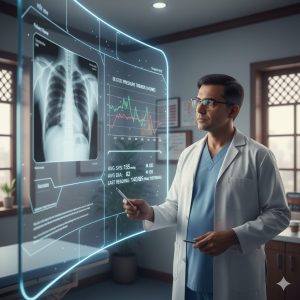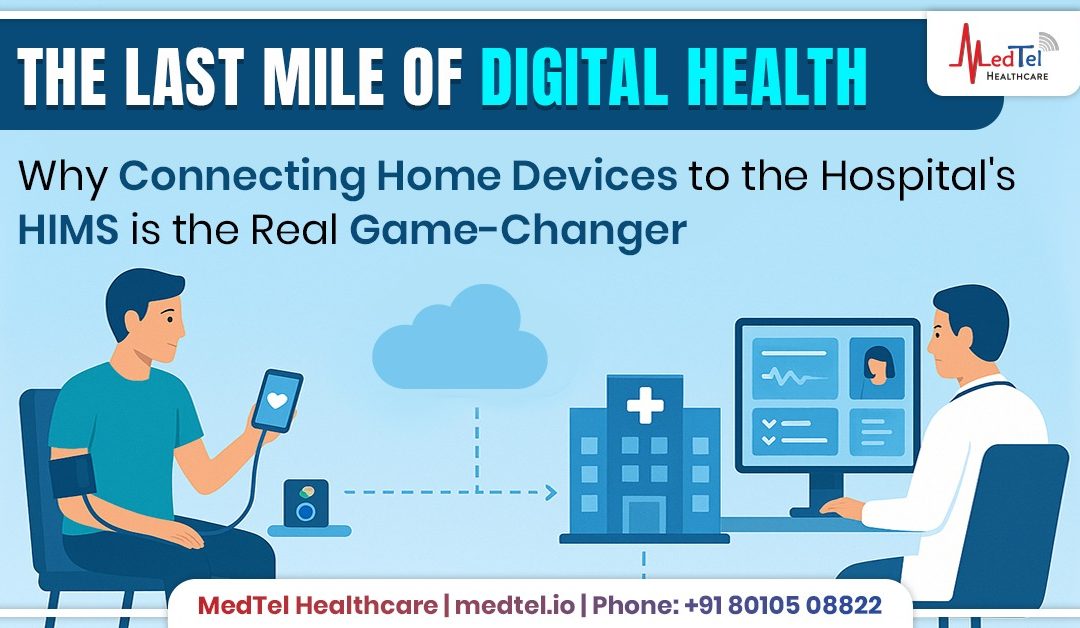The revolution in healthcare is happening in our living rooms. Smartwatches track our heart rhythms, connected cuffs monitor our blood pressure, and intelligent scales help us manage chronic conditions. We have more personal health data at our fingertips than ever before. It’s an incredible leap forward for patient empowerment.
But a critical question often goes unasked: Where does all this valuable data go?
For most people, it lives on an app on their smartphone—a digital island, disconnected from the very place it’s needed most during critical moments: the hospital.
The true potential of remote care is only unlocked when we build a bridge from these home devices to the hospital’s central brain: the Hospital Information Management System (HIMS). This isn’t just a technical detail; it’s the last, crucial mile of digital health that creates a truly seamless circle of care. Here’s how.
1. Beyond the App: Creating a True 360-Degree View of Health
Right now, most patients have two separate health stories. There’s the “at-home” story, told through daily readings on an app. Then there’s the “in-hospital” story, a detailed record of major events, procedures, and lab results stored in the HIMS. The two rarely meet.
Integrating home device data directly into the HIMS merges these two narratives. Imagine a hospital-based cardiologist preparing for a patient’s follow-up. On one screen, they can see the results from the patient’s last hospital EKG right next to a continuous graph of the patient’s daily blood pressure and heart rate trends from the last six months at home.

This complete, 360-degree context is invaluable. It helps clinicians make more precise medication adjustments, understand long-term treatment effectiveness, and move from just treating events to managing a person’s entire health journey.
2. The Golden Hour: Transforming Emergency Care with Context
In an emergency, time and information are the most precious resources. This is where HIMS integration can be life-saving.
Consider this scenario: A patient with a chronic heart condition, who is being monitored at home, suddenly feels unwell and is rushed to the emergency room.
- Without Integration: The ER team starts from scratch. They see the patient’s immediate symptoms but are blind to the crucial events of the last 48 hours.
- With HIMS Integration: The moment the patient is checked in, the ER doctor accesses their record in the HIMS. They don’t just see the patient’s history; they see a live feed of their home device data. They can immediately spot a two-day trend of declining oxygen levels or a subtle but steady rise in weight that preceded the crisis.
This context is priceless. It helps the team diagnose the problem faster and more accurately, turning a reactive guess into an informed, immediate response.
3. Empowering Specialists: The Hospital as a Remote Care Command Center
The top specialists for complex diseases—endocrinologists, pulmonologists, nephrologists—are typically based in hospitals. HIMS integration allows them to extend their world-class expertise far beyond the hospital’s physical walls.
The HIMS becomes their command center. They can monitor hundreds of their patients at home directly from the system they use every day. They can set up intelligent alerts tailored to each patient. For example, a specialist can get an automated notification in the HIMS if a post-transplant patient’s blood pressure exceeds a certain threshold. This allows hospitals to run sophisticated remote care programs efficiently, bringing the specialist’s watchful eye directly into the patient’s home.
4. From Discharge to Recovery: Closing the Loop to Prevent Readmissions
One of the biggest challenges for hospitals is the “revolving door”—when patients are readmitted shortly after being discharged.
HIMS integration is the most powerful tool to solve this. When a patient is discharged with connected devices, the hospital’s care team can monitor their recovery through the HIMS. They can track key metrics to ensure the patient is stable and adhering to their care plan. If a warning sign appears, the team is alerted and can intervene with a telehealth call or a medication adjustment, preventing a small problem from becoming a big one that requires another hospital stay.
This “post-discharge surveillance,” managed through the hospital’s own core system, closes the loop between hospital care and home recovery.
Ready to Build the Bridge?
The journey from isolated data to an integrated, intelligent system starts with the right foundation. Our powerful, API-ready platform is designed to make connecting remote care devices to your HIMS simple, secure, and scalable.
Book a personalized demo today to learn more about our API-ready platform for HIMS integration and start building the future of connected care.
